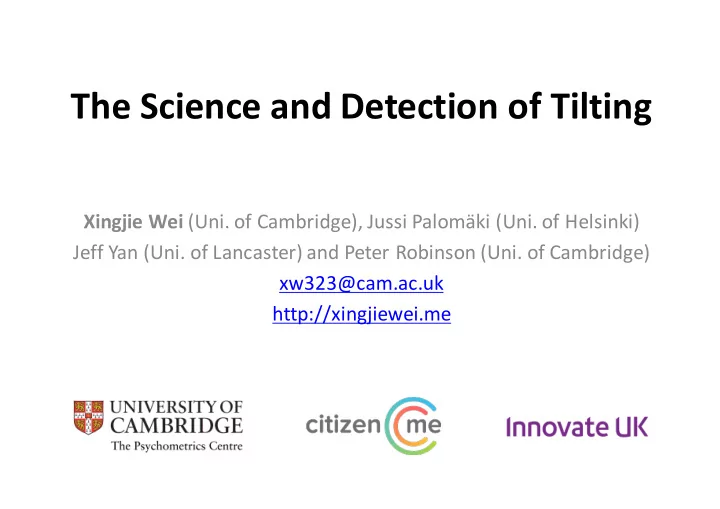

The Science and Detection of Tilting Xingjie Wei (Uni. of Cambridge), Jussi Palomäki (Uni. of Helsinki) Jeff Yan (Uni. of Lancaster) and Peter Robinson (Uni. of Cambridge) xw323@cam.ac.uk http://xingjiewei.me
Poker • Played by > 100 M players worldwide (most online) • Market value (online poker): billions $$$ / year • Cultural significance – Movies/TV: James Bond, X-Men – Everyone is familiar with terms like bluff , poker-face • Scientific significance – Involves constant decision-making & risk analysis – Inspired game theory (the study of strategic cooperation and conflictbetween intelligent rational decision makers ) 2
Texas hold 'em Play 2 Play 1 3
Rank 1, Straight flush On the first 3 cards: AK vs. KK: < 1% win rate 2, Four of a kind On the first 4 cards: AK vs. KK: 4%~5% win rate 3, Full house Play 2 (AK) 4, Flush Texas hold 'em 5, Straight 6, Three of a kind Play 1 (KK) 7, Two pair 8, One pair 9, High card Play 2 Play 1 4
Tilting • Refers to losing control due to negative emotions, making detrimental decision and thereby losing superfluous amounts of money – Losing despite being a strong statistical favourite to win (i.e. losing due to bad luck) – Prolonged series of losses (losing streaks) – External factors external (e.g. fatigue, needling by other players) “I deserved to win but didn’t; I have to win back what was/is mine” 5
The study of tilting Why • Highly prevalent among poker players – Within last 6 months of playing, 88% reported having tilted severely at least once, 43% > 5 times, 24% > 10 times • Causes significant detrimental consequences – E.g. losing entire life saving in a singe 20-min session • Rarely studied – Current: based on subjective self-reports from players Helps to better understand how emotions influence our behavior and well-being 6
The study of tilting What We know how tilting feels (subjectively), but not what it actually looks like (objectively) • How does tilting manifest via facial expressions? • Is this manifestation automatically detectable via computer vision methods? Computing techniques à Psychologicalbehaviour 7
The study of tilting How • Map the facial (micro) expressions detected during actual tilting behaviour by employing facial expression analysis techniques • Pioneer the development of an automatic system that detects expressions of tilting and warns players when tilting is imminent ( Tilt-detector ) You’re titling now ! Facial expression understanding and modelling Warning Web camera Automatic facial expression recognition Playing data 8
Framework Tilting modelling • Facial expression ↔ tilting behaviour • Co-occurrence / mutual exclusion relationships among AUs Playing diary Landmarks detection • Temporal relationships of AUs Tilting Poker hand AU detection Face registration Prior knowledge labeling records Tilting ? Feature extraction Training Classifier Video Non-tilting ? Testing Data processing Data collection Non-labeled Video Tilting detection 9
Data collection • Poker hand records – Using poker tracking and analysis software • Playing diary – Perceived cause (e.g., bad beat) – Exact time and duration – Perceived severity of tilt – Descriptions of the emotions felt 10
Framework Tilting modelling • Facial expression ↔ tilting behaviour • Co-occurrence / mutual exclusion relationships among AUs Playing diary Landmarks detection • Temporal relationships of AUs Tilting Poker hand AU detection Face registration Prior knowledge labeling records Tilting ? Feature extraction Training Classifier Video Non-tilting ? Testing Data processing Data collection Non-labeled Video Tilting detection 11
Data processing • Action unit (AU) detection 12
Framework Tilting modelling • Facial expression ↔ tilting behaviour • Co-occurrence / mutual exclusion relationships among AUs Playing diary Landmarks detection • Temporal relationships of AUs Tilting Poker hand AU detection Face registration Prior knowledge labeling records Tilting ? Feature extraction Training Classifier Video Non-tilting ? Testing Data processing Data collection Non-labeled Video Tilting detection 13
Tilting modelling • Facial expression ↔ tilting behaviour – Titling AU set vs. non-tilting AU set – Tilting AU set vs. AU sets of other basic facial expressions • Co-occurrence / mutual exclusion relationships among AUs – Probabilistic graph models, e.g., Bayesian networks • Temporal relationships of AUs – Dynamic Bayesian Network (DBN) – Hidden Makov Model (HMM) 14
Framework Tilting modelling • Facial expression ↔ tilting behaviour • Co-occurrence / mutual exclusion relationships among AUs Playing diary Landmarks detection • Temporal relationships of AUs Tilting Poker hand AU detection Face registration Prior knowledge labeling records Tilting ? Feature extraction Training Classifier Video Non-tilting ? Testing Data processing Data collection Non-labeled Video Tilting detection 15
Significances • Authentic and spontaneous negative emotion data – First in the world on actual tilting behaviour – Negative emotion: more difficult to obtain in naturalistic conditions • Tilting prevention solution for poker 16
Applications in other contexts • Other gambling: people chase their losses • Road rage – Aggressive or dangerous behaviour • Game & sports – Tilted in Starcraft 2 : player lose self-control • Rapid multiple decisions – online stock trading which is influenced by emotions 17
Thank you • Xingjie Wei • xw323@cam.ac.uk • http://xingjiewei.me • www.psychometrics.cam.ac.uk 18
Recommend
More recommend